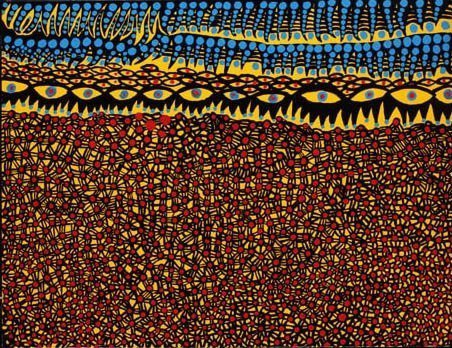Yayoi Kusama
dal 8/2/2012 al 14/4/2012
Segnalato da
8/2/2012
Yayoi Kusama
Victoria Miro Gallery, London
New Paintings. The paintings have been selected from a major series commenced during the past three years. Initially conceived by Kusama to comprise a hundred paintings, the series has, with characteristic dynamism, grown far in excess of that number. The result is a magnum opus, a vibrant flowering of an artist whose six-decade career has been a constantly evolving enquiry into the twin themes of cosmic infinity and personal obsession.

Victoria Miro Gallery is delighted to announce an exhibition of new paintings by Japan's most revered contemporary artist, Yayoi Kusama.
The paintings have been selected from a major series commenced during the past three years. Initially conceived by Kusama to comprise a hundred paintings, the series has, with characteristic dynamism, grown far in excess of that number. The result is a magnum opus, a vibrant flowering of an artist whose six-decade career has been a constantly evolving enquiry into the twin themes of cosmic infinity and personal obsession.
The paintings are at once startlingly innovative and classically Kusama. Completed in a single session, each is a flatly painted monochrome field that abounds with imagery including eyes, faces in profile and other more indeterminate forms, often in pulsating combinations of colour. From the psychedelically primordial My Forsaken Love, in which biomorphs traverse a black-fringed molten-pink ground, to the strata-like composition of Standing on the Riverbank of My Hometown I Shed Tears, a canvas filled with sedimentary layers of cell-like dots, eyes and extravagantly decorated lashes, the paintings generate new motifs and arrangements of forms while continuing a lifelong preoccupation with the mysteries of the physical and metaphysical, the tangible and ineffable - the space where seeing and feeling intersect.
These are fluid, highly instinctual, improvisatory works. In Look at the Women Singing Out Love and Finding Myself In The Midst of Creation, repeated profiles create insistent rhythms, while in Love, Birth And Death, And Illness, And What is Happiness? a shoal of eyes, variously narrow and wide as if scrutinising their surroundings, provide a bass beat for a quizzical encounter between semi-abstract forms that seem on the cusp of coalescence.
When looking at these paintings we might think of Paul Klee's famous statement about taking a line for a walk. In Kusama's hands, the irreducibly basic elements of art - the dot, the line - assume poetic urgency, gathering together strands of the sensory, sensual and personal as they traverse the canvas. Distinctions between drawing and painting, figuration and abstraction, internal and external worlds are erased in works that do not obey convention but invent their own pictorial logic. Often, a disconcerting sense of depth and scale is in evidence. Flatness gives way to illusory space, background motifs jump in scale as they move centrestage. As viewers we negotiate a world of multiple viewpoints, where flux and disorientation, expressions of Kusama's personal experience, are part of the encounter.
There is a palpable sense of the artist's hand pushing ever onwards in these works, making discoveries as it goes. Yet, motifs familiar from Kusama's oeuvre remind us of preoccupations that can be traced back to the hallucinations first experienced by the artist in childhood. The cell-like dots that proliferate in The Sun Is Loved By Everybody and A Talk About Boundless Love, And All About Love are instantly recognisable as variations of the multiplying polka dots that feature in Kusama's work from as early as 1939. The optical complexity of these paintings might be thought of as a graphic distillation of the endlessly refracted worlds of Kusama's enveloping mirrored environments first created in the 1960s.
It is fascinating to consider these recent works in tandem with the artist's forthcoming retrospective at Tate Modern, where the genesis of Kusama's visual language is revealed along with her art historical prescience. Covered with undulating loops of paint, the Infinity Net paintings, first produced by the artist in New York in the late 1950s, act as a conduit between abstract expressionism and minimalism. First made in the early-1960s, Kusama's soft sculptures adorned with phallic-like protuberances anticipate the work of Claes Oldenburg, while her use of wallpaper and collages incorporating elements such as airmail stickers would have a profound influence on Andy Warhol. Today, we are as familiar with the highly personal, confessional style of art pioneered by Kusama decades ago as we are used to her command of different media. These new paintings allow us to consider the artist's unique vision as conjured by nothing more than brush, paint and canvas. They are a distillation of the themes that characterise Kusama's art, grounded in the known world but grasping towards the unknown and the unknowable.
Opening Feb. 8th
Victoria Miro
16 Wharf Road London N1
Open Tuesday to Saturday 10am to 6pm
Admission free



